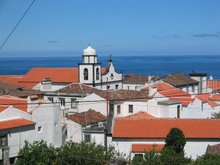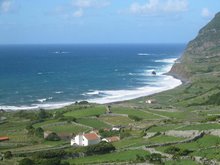I like museums and I can't resist going in to them. The best ones are those which have working exhibits in glass cases with a button you can press and the exhibit - a Newcomen engine drawing water out of a flooded mine shaft or something like that, ideally - starts working.
But if there's one thing I can't be doing with, it's museums which turn out to be full of bits of broken pots. This is the era of Scottish history we've arrived at - the Pot Age.
I'm being flippant of course (moi?) because what I'm actually referring to here is the transition from the Mesolithic Era (Middle Stone Age) to the Neolithic (New Stone Age). It is the most seminal moment in the history of mankind because it's when we moved from acquiring food by hunting/picking wild animals/plants to harvesting domestic animals/plants: farming. This was a bigger step than the Industrial Revolution, the internal combustion engine and Microsoft Windows all rolled into one - it was verging on tomato ketchup in squeezy plastic bottles instead of glass ones in significance as a milestone in the development of human civilisation.
The Neolithic revolution started about 5,000BC in the Middle East. Of course, it didn't just happen on a single day when everyone was invited to drop off their wild boar hunting spears and berry picking - er - picking implements - and take away a sack of seed and a couple of lambs and a calf in exchange. Farming took time to spread out around the world with old habits dying hard. It reached Scotland in about 3-4,000BC (give or take the usual milennium or two), a couple of thousand years after it had been invented.
The two greatest Neolithic monuments in Scotland are:-

That's Skara Brae in Orkney - an archipelago off the north coast of Scotland where the geology is such that the rock splits very nicely for building purposes so it's a kind of Stone Age paradise. Skara Brae is a bit of a broken pot as major league international archaeological sites go (Machu Picchu, Angkor Wat, et al can sleep easily) but it is reckoned to be the best preserved neolithic village in Europe. (I dread to think how dull the second best preserved one must be - it's probably in somewhere like Tubingen in Germany that, with luck, I will be spared ever going to.)
The second most famous Neolithic monument in Scotland is a bit more interesting:-

But if there's one thing I can't be doing with, it's museums which turn out to be full of bits of broken pots. This is the era of Scottish history we've arrived at - the Pot Age.
I'm being flippant of course (moi?) because what I'm actually referring to here is the transition from the Mesolithic Era (Middle Stone Age) to the Neolithic (New Stone Age). It is the most seminal moment in the history of mankind because it's when we moved from acquiring food by hunting/picking wild animals/plants to harvesting domestic animals/plants: farming. This was a bigger step than the Industrial Revolution, the internal combustion engine and Microsoft Windows all rolled into one - it was verging on tomato ketchup in squeezy plastic bottles instead of glass ones in significance as a milestone in the development of human civilisation.
The Neolithic revolution started about 5,000BC in the Middle East. Of course, it didn't just happen on a single day when everyone was invited to drop off their wild boar hunting spears and berry picking - er - picking implements - and take away a sack of seed and a couple of lambs and a calf in exchange. Farming took time to spread out around the world with old habits dying hard. It reached Scotland in about 3-4,000BC (give or take the usual milennium or two), a couple of thousand years after it had been invented.
The two greatest Neolithic monuments in Scotland are:-

That's Skara Brae in Orkney - an archipelago off the north coast of Scotland where the geology is such that the rock splits very nicely for building purposes so it's a kind of Stone Age paradise. Skara Brae is a bit of a broken pot as major league international archaeological sites go (Machu Picchu, Angkor Wat, et al can sleep easily) but it is reckoned to be the best preserved neolithic village in Europe. (I dread to think how dull the second best preserved one must be - it's probably in somewhere like Tubingen in Germany that, with luck, I will be spared ever going to.)
The second most famous Neolithic monument in Scotland is a bit more interesting:-

These are the standing stones at Callanish (or Calanais if you prefer the Gaelic spelling. I don't.) This is the "Scottish Stone Henge" on the island of Lewis in the Outer Hebrides off the west coast of Scotland. I also have the pleasure to be able to record that, unlike Stone Henge, Callanish is not plagued by dirty, hippy, druidy types and you're still perfectly able to go there unmolested on Mid Summer's Day if you wish ...
And at this point - as this is history without looking any of it up to check - I've realised I may be talking out of an orifice which is not the one I normally talk out of and that Callanish may be later than Neolithic and may actually be Bronze Age - another couple of thousand years on. Sort of roughly 1-2,000BC-ish. Still a bloody long time ago by anyone's standards.
The Neolithic move to farming as opposed to hunter gathering was not all good news, however, and had two unpleasant side-effects: (a) war - the theory goes that the extra food generated caused a population explosion which led to pressure on available resources and a "get off my land" attitude. Anthropolgists reckon that they have never yet found a pointed or a heavy thing designed to kill another human as opposed to a seal or a wild boar dating back to hunter gathering days: so John Lennon would have been in his element in the Mesolithic; and (b) people started making pots, the broken consequences of which are still haunting us to this day as well. There was, indeed, a race known as "the Beaker People" after their distinctive beaker shaped pots. Whether they were Neolithic or Bronze Age, I forget but it's an ignoble soubriquet, I've always felt. It would be a bit like us being referred to as the Condom People or something like that ...
(Unrelated, but does anyone remember the Bleakers? 60s sci-fi comic strip - I've a notion it was in the Blue Peter annual of all things - Yes, No?)
And at this point - as this is history without looking any of it up to check - I've realised I may be talking out of an orifice which is not the one I normally talk out of and that Callanish may be later than Neolithic and may actually be Bronze Age - another couple of thousand years on. Sort of roughly 1-2,000BC-ish. Still a bloody long time ago by anyone's standards.
The Neolithic move to farming as opposed to hunter gathering was not all good news, however, and had two unpleasant side-effects: (a) war - the theory goes that the extra food generated caused a population explosion which led to pressure on available resources and a "get off my land" attitude. Anthropolgists reckon that they have never yet found a pointed or a heavy thing designed to kill another human as opposed to a seal or a wild boar dating back to hunter gathering days: so John Lennon would have been in his element in the Mesolithic; and (b) people started making pots, the broken consequences of which are still haunting us to this day as well. There was, indeed, a race known as "the Beaker People" after their distinctive beaker shaped pots. Whether they were Neolithic or Bronze Age, I forget but it's an ignoble soubriquet, I've always felt. It would be a bit like us being referred to as the Condom People or something like that ...
(Unrelated, but does anyone remember the Bleakers? 60s sci-fi comic strip - I've a notion it was in the Blue Peter annual of all things - Yes, No?)




1 comment:
You bring new meaning to the expression "a mess of pottage." Also, your comment that "the most seminal moment in the history of mankind [is] when we moved... to harvesting... plants" has double meaning, because "seminal" originally referred to seeds. Please, please, stop me before I pun again -- or else just pun-ish me ;-)
BTW, I'm gratified to read of your recognition of the significance of the plastic ketchup bottle, inasumuch as the Pittsburgh, Pennsylvania, area (where I live) is home of Heinz 57 Varieties, including the aforementioned tomato-based condiment!
Post a Comment